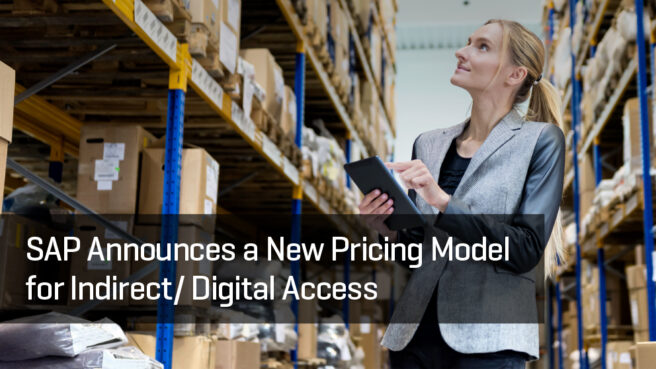SAP Announces a New Pricing Model for Indirect/ Digital Access

On April 10, 2018, SAP announced a comprehensive new pricing model for Indirect Access. The existing user-based license models (with the “Platform User” as the designated license type in SAP’s price list) will be replaced in their current form. This follows on from Bill McDermott’s address at SAPphire last year announcing that SAP would like to change the policy around Indirect Access, specifically around two types of orders: procure-to-pay and order-to-cash.
It was quite obvious something was missing back then as it doesn’t make sense to only count orders. What we see is a logical evolution. SAP has come up with nine different objects that need to be counted.
However, in my opinion, I wouldn’t recommend existing customers automatically adopt this new pricing model as whether it will benefit them depends on their specific situation. They should carefully assess whether they should move onto to this new model or stay with the old.
What exactly is changing?
The new license models are designed to focus in particular on the value added that SAP customers generate by creating certain documents in the SAP system. Whether, and to what extent, these are advantageous for the customer cannot yet be assessed at this point.
At present, the new model is difficult to evaluate, especially as the prices have yet to be fixed. But even if prices were fixed, organizations would first have to check whether switching to the new model would be worthwhile. This is anything but easy, especially for those organizations still using older versions or Service Packs from SAP. The SAP tools that help with the measurement may not be available to them.
Indirect/ Digital Access
Indirect Access occurs when a non-SAP system triggers the creation of processes and documents within an SAP system. Until very recently, in the user-based Indirect Licensing model, just reading data from an SAP system in an interactive way constituted Indirect Access.
Examples include:
- A system like Salesforce triggers a sales order in SAP
- A purchase at Amazon creates an EDI (Electronic Data Interchange) document
- A web shop uses inventory data from SAP (“6 in stock”).
Interestingly, Indirect Access does not occur if the customer uses other SAP applications such as Fieldglass, Hybris, SuccessFactors, Concur or Ariba to access data from the main SAP system.
What does this mean for existing customers?
Companies with legacy contracts in which license fees for Indirect Access had not yet been created, as well as companies that still have contracts with SAP for user-based license types such as NetWeaver Foundation for Third Party Applications or Platform Users, should carefully examine whether the new regulation is advantageous or disadvantageous for their SAP landscapes.
For SAP it’s a good move because in general it’ll potentially make things a lot simpler: as SAP will provide a measurement tool that enables customers to check for themselves how many objects will be counted. Ultimately, even if it’s not cheaper than the old model, SAP’s customers may prefer the new model as it is more transparent.
What should companies do from a Software Asset Management perspective if they want to evaluate the new model?
Businesses have to look at what external systems are connected to the SAP environment, how many users are connected, and what they pay for each user depending on their specific license type.
The future direction of the company should also play a role: Should more suppliers and customers be networked in the future? The more data is exchanged, the higher the fees may be.
Using the new model, organizations can fire up and use the new measurement routine, and based on what they can see make some small adjustments to their license allocation based on usage. As a consequence they can see how much they will owe SAP. As the reporting is now transparent, SAP no longer has to replicate the customer’s analysis and the audit team will find it more straightforward to assess whether any true up is needed.
Other changes and considerations
SAP also recently snuck in some changes in their internal organization: the audit team is now separate from the sales team. Now that they are independent of each other, the sales team can no longer trigger or threaten the customer with an audit. (see David Morrison’s earlier blog post on Simplifying SAP License Audit Submissions)
Looking at it from their side, SAP has increased the number of people working in the audit team by so many that they have to make it an independent practice. As a result, I predict there will be an increasing number of audits in future and because the audit team is no longer dependent on the sales team, their performance will be linked to the revenue generated from an audit and not from additional SAP sales. I can also imagine the revenue objectives of the audit team will be tied to SAP’s overall targets. With this increased reliance on audits to squeeze more money out of their customer base, SAP risks becoming unpopular, following the example of Oracle, which has a very poor reputation among its customer base.
How Snow can help
Currently our own solution, Snow Optimizer for SAP® Software, already helps with many issues around SAP licensing including Indirect Access: building a baseline, optimizing user licenses, managing and administrating users and license contracts, controlling engines, automating processes, and controlling and mitigating Indirect Usage. Once the new Digital Objects measurement tool is made available by SAP we will also build its logic into our own solution and add more value than the SAP-provided tool.
If you want to know more about how Snow Optimizer for SAP Software can mitigate risks around Indirect Access contact us today. Why not also download Four Steps To Reduce Sap® Indirect Access Risk, an essential guide for SAP best practice to ensure you get full visibility of your SAP estate.